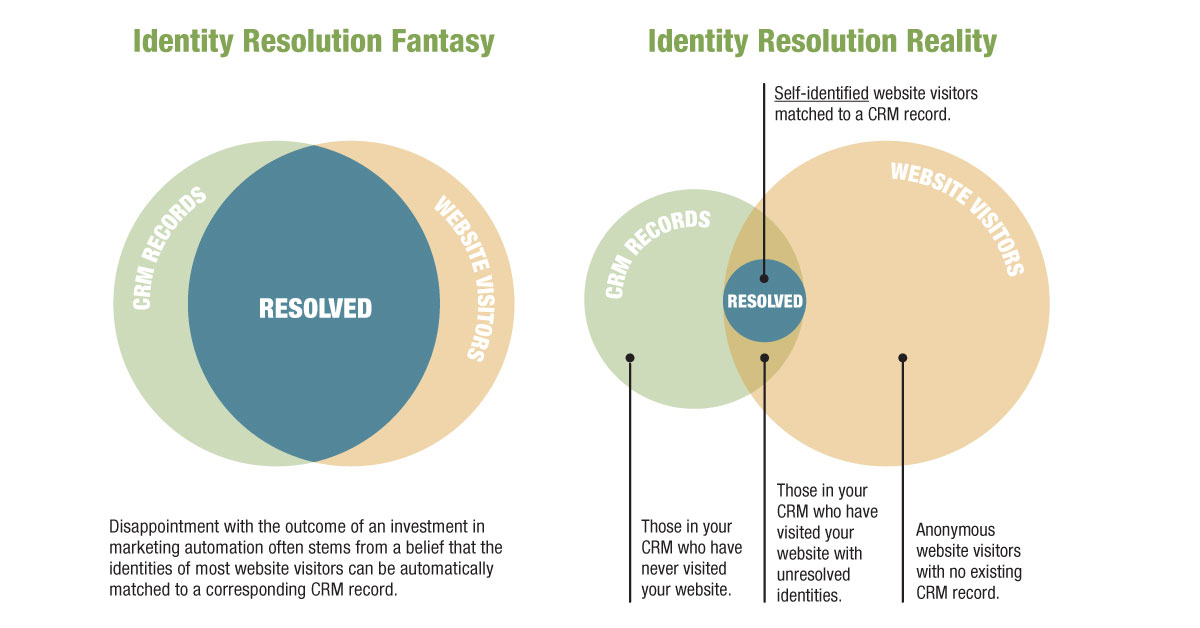Identity Resolution: The Personalized Marketing Success Factor No One Else Tells You About
By Neil Ruffolo, Director, Digital Strategy
Every B2B digital marketer has heard this at least once: “I just want to know who is visiting our website.”
It is the Holy Grail of lead generation, but not a wholly unreasonable thing for someone to expect. After all, it is customary for everyone who visits or calls an office in real life to provide a name and contact info. Anyone who refuses to do so is shown the door immediately. But the same rules do not apply online.
Anonymity is and always has been the default in cyberspace. Yet many executives still expect technology to provide an easy way to identify website visitors. Unfortunately, few things are as simple and easy as we want them to be. And that is particularly true when personal privacy is at stake.
Putting a Name to a Face
Digital identity resolution is a common obstacle for manufacturers that do not have a history of engaging with end-users. Also called cookie-based matching, it involves pairing anonymous website activity data with an existing record in your CRM – like putting a name to a face. The catch is that identity resolution cannot be unilateral. It requires the consent and cooperation of your website visitors.
In the digital realm, the basic unit of personal identification is an email address. Like a fingerprint, it is unique to an individual. Two people can work at the same company and have the same name, but not the same email. So Identity resolution typically occurs when a website visitor provides their email address via a form on your website. Only then can your marketing automation or visitor intelligence software connect their website activity to an existing CRM or CDP record. For new contacts, a new resolved contact record is created on the spot.
Identity Resolution Fantasy vs. Reality
The way surveillance tech is portrayed in the media helps drive the myth that anyone can be identified no matter where they go. If you’ve ever watched a police procedural drama, the idea that it is possible to unmask everyone who visits a website might not seem so far fetched. And the developers of lead generation and marketing automation software have done little to dispel this belief. In fact, “Caller ID for Your Website” was the tagline used by VisitorTrack for years – as late as 2020. That sounds great! Too bad it is also fiction.

Like most myths, there is a kernel of truth to the notion that you can unilaterally ID anonymous website visitors. Google Ads, Oracle Data Cloud, The Trade Desk, and MediaMath all have access to massive amounts of data and tracking mechanisms that can link online activity to an individual. And marketers do in fact use this anonymized data for targeted advertising via a DSP (Demand Side Platform). But even this sort of arm’s length access to data may be limited even further going forward.
Market pressures and the regulatory environment surrounding PII (Personally-Identifying Information) are ever-changing. Laws like CCPA (California Consumer Privacy Act) and Europe’s GDPR (General Data Protection Regulation) have placed legal restrictions on the collection and sharing of PII. And by 2022 Google Chrome will join Safari and Firefox web browsers by extending privacy protections to block third-party tracking by default. No matter how things play out, one thing is for sure. The use of third-party data for personalized marketing is not going to get less restrictive. This means collecting first-party PII will become even more important for manufacturers adopting a customer-centric growth strategy.
Seeing Beyond the Hype
Identity resolution is a key success factor that is often glossed-over by Marketo, Pardot, Hubspot, and other software platform sales reps. That’s not to suggest any treachery or collusion among these developers. The truth is that many software reps are just not very familiar with the through-channel business model. They lack an intimate understanding of two-step distribution. So many will tell you what they think you want to hear based on what they know from other business sectors. A Dorn office outing to an Asian restaurant illustrates what I am talking about:
Our waiter was very pleasant and attentive, but he had a rather heavy accent. We could understand only about 20 percent of what he was saying. And I presume he would say the same of us. In spite of the language barrier, our ability to communicate was good enough to order numbered menu items. However, a member of our group is on a strict diet. When asked about gluten-free options our waiter responded with enthusiastic confidence in crystal clear English: “Yes. Gluten-free. No Problem. Noooooo problem. We take care of you.” Then he returned to the kitchen without another word.
In spite of the waiter’s assurances, we were not confident he understood the serious health issues at stake. It felt like he was reciting the words he knew we wanted to hear. And our co-worker who would face the possibility of gastrointestinal upheaval was justifiably worried. He decided to take the risk anyway. Luckily everything turned out ok this time, but it could have gone the other way.
The response of our waiter to “Do you have any gluten-free options?” is a lot like that of a software sales rep when asked, “Can you tell me who is visiting my website?” Both questions are met with confident assurances whether they understand the situation, or not. To make an informed decision and avoid disillusionment you must see beyond the hype.
Digital identity resolution is a much lower hurdle for distributors or B2C retailers who sell directly to end-users. Manufacturers should take this into account before diving head-first into a heavy investment in marketing automation. The payoff could take a bit longer than you were told. And success will probably take additional investments in end-user demand generation and engagement programs, like content marketing and/or conversion rate optimization (CRO). Being aware of this is important because once you commit to a marketing automation platform, you are pretty much stuck with it. Switching to another one usually means abandoning your historical data and starting over from scratch. This includes all those matched digital identities.
5 Ways to Match More Identities
B2B customers value and protect their anonymity online. They know that revealing who they are could mean a barrage of emails, digital ads, and/or sales rep calls from your company. So you must offer something worth it in return. “Subscribe to Our Newsletter” won’t get you very far.
Identity resolution is not easy, because it cannot be bought from a third party. You must earn it. Here are 5 ways manufacturers can match more digital identities, generate leads, and maximize marketing automation ROI:
- Giveaways. Entry into a random drawing can be a good way to entice people to your website and identify themselves. Professional tools and equipment make good prizes because the value overcomes the desire to remain anonymous. Photo submission entries are a variation of this concept that attracts tradespeople, technicians, and other end-users who take pride in their work. Not only does it offer an opportunity to show-off, asking for a photo will discourage many sweepstakes junkies. Note that giveaways and sweepstakes should comply with local gambling and “no purchase necessary” laws. That’s not hard to do, but we always recommend consulting your legal department about the details, including the official rules.
- Online Rebate Application. If you have the processes in place to offer a manufacturer rebate to end-users, consider taking applications on your website instead of by mail, or a through-channel discount. The chance to reduce the cost of industrial equipment and supplies will be reason enough for customers to reveal their identity.
- Warranty Registration. If you are still accepting warranty registrations by mail, stop it. When accepted by an online form managed by your marketing automation software, you can further develop the post-purchase relationship with your brand. This forms the basis of customer loyalty programs because you also have a de facto purchase history.
- Gated Content. Requiring registration before providing access to a piece of digital content is called gating. Sales literature like white papers, or case studies are commonly gated. But you don’t need a content marketing program, or a brand journalist to create gated content. Manufacturers have a lot of existing material that could be gated. Digital documents like product catalogs, datasheets, regulatory certifications, user manuals, and demonstration videos contain valuable information customers need. A name and email are not too much to ask for in exchange.
- E-Commerce. If you are not already selling direct to end-users online, then maybe it’s time to start an e-commerce pilot program. Identifying your customers is not an issue when you own the point of sale. Manufacturers today often engage in direct sales without ruffling the feathers of existing channel partners. One way is to focus on serving a niche segment that dealers tend to ignore. Instead of leaving this business on the table, why not service it in-house? E-commerce coupled with marketing automation forms the foundation of a segment development strategy and a hedge against the uncertain future faced by distributors.
One-to-one marketing automation is a mature technology that has earned its place in the marketing communications mix. Successful adoption will boost sales productivity, strengthen brand loyalty, and fuel business growth. Manufacturers, in particular, need an identity resolution strategy to realize this potential.




